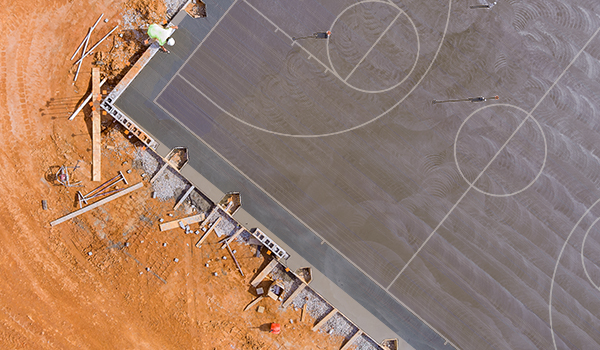
Construction is like one of those complex math problems that students dread on a final exam. The stakes are high. Even a minor error will result in the wrong answer—no partial credit, just wrong.
What if you had chance to correct your work? Would a mistake in the beginning be more difficult to resolve than a mistake near the end? Of course. An early error might require you to start over, but a late error might be an easy fix. It’s almost as if the steps “build” on one another.
Now do you see the relation to construction? Avoiding costly errors on the job site is exactly like avoiding them on a math test: check your work as you go, before moving to the next step. For example, it’s better to know about a problem with your building’s foundation before a work crew framing in the fourth floor.
For gym floors, “checking your work as you go” means checking the concrete slab. The amount of moisture in the slab can be particularly problematic. If the relative humidity exceeds the manufacturer’s tolerance, do not install the floor without resolving it!
Most sports floors have an acceptable moisture tolerance set by the manufacturer. If a floor is installed over a concrete slab that exceeds the recommended tolerance…well, you can’t say we didn’t warn you. Here’s a short list of what might happen:
- Hardwood courts can buckle as the wood absorbs more or less moisture. That makes the court not just unsightly, but also prone to causing injuries.
- Certain types of adhesives can fail. The only thing moving on a basketball court should be the players, not the floor. If that’s not the case, we have a big problem.
- Moisture in the slab can cause bubbles. This results from hygroscopic pressure in the concrete. Bubbles are fine in carbonated drinks and champagne, but not so much on a gym floor. Preventing this problem is much easier than correcting it.
None of these potential problems are caused by the installation or the type of flooring. The error comes from the previous step. So what can you do to make sure a concrete slab is ready for a sports floor? Here’s an essential checklist.
- Grading. Make sure that rainwater is shed away from the building. Grading might seem far removed from installing floors, but it makes a difference. You might encounter this problem more often in renovation work, but it can happen in new construction as well.
- Curing. This one is related to new buildings. Pressure to meet construction deadlines is always there, but if the concrete slab isn’t properly cured, there might be pressure of a different type to cause headaches later on. Waiting the right amount of time can prevent a flooring nightmare in the future.
- Testing. This is what we mean by “checking your work as you go.” By testing the moisture conditions, you can confirm that the site is ready for flooring installation. This isn’t a step you should skip. As it turns out, flooring contractors like Abacus Sports can do a lot to fix “less than perfect” concrete. Although, we have to know about it first. The most common method of testing uses the in-situ probe outlined in ASTM 2170. This test provides the relative humidity (RH) percentage in the concrete. Make sure testing is done in multiple locations in the slab, not just one. If the results fall outside of the recommended tolerance, we can use moisture mitigation and underlayment barriers to solve it.
These factors are important, but there is more you can do. Keep in mind that your flooring installer is invested in a good result. It’s a good idea to involve them in the process, especially flooring contractors with lots of experience. They know well the impediments to a good installation and they can help you identify and avoid them. Abacus Sports Installations is one of those experienced contractors. Give us a call. We’re ready to help.
